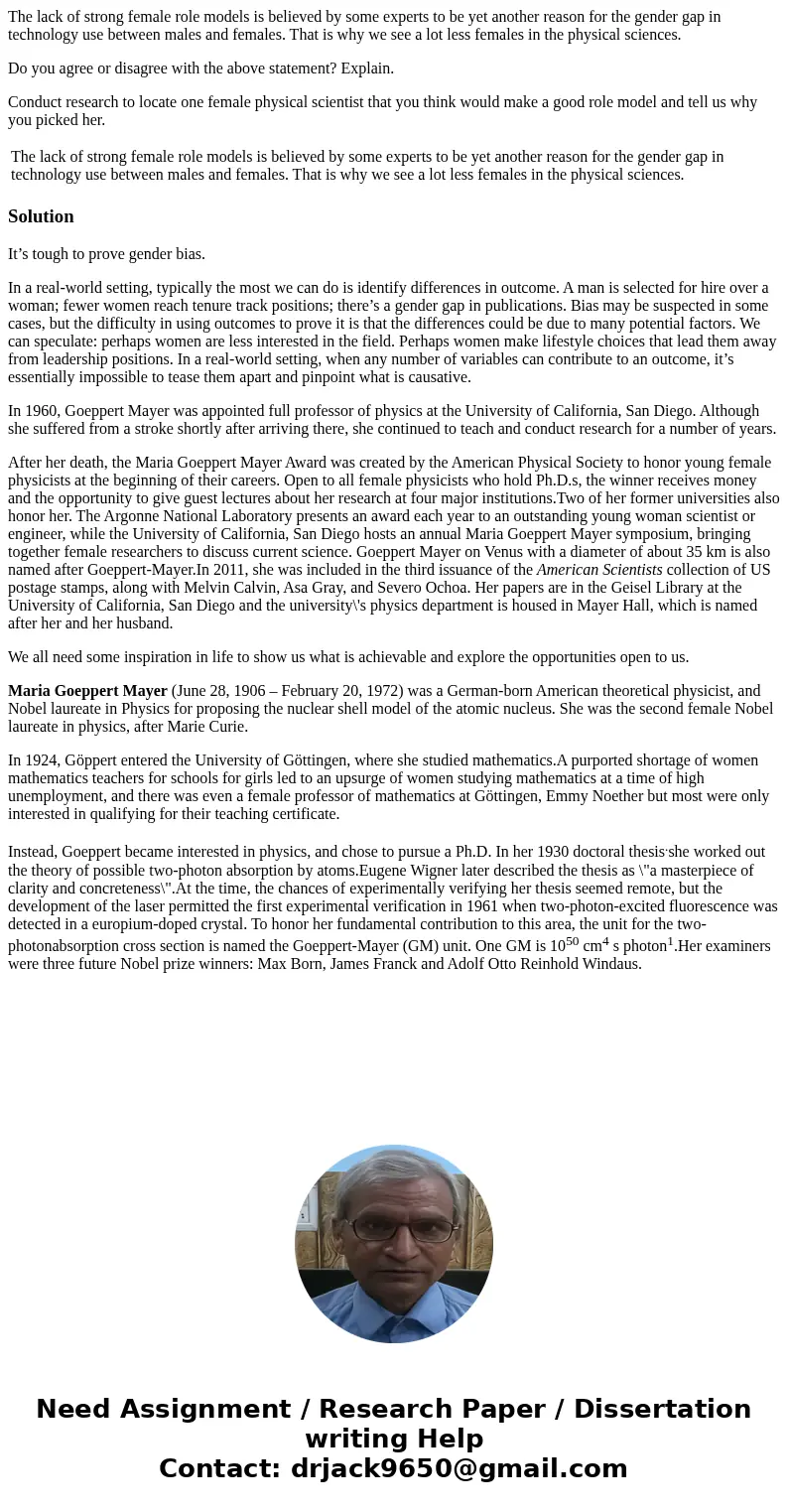The lack of strong female role models is believed by some ex
The lack of strong female role models is believed by some experts to be yet another reason for the gender gap in technology use between males and females. That is why we see a lot less females in the physical sciences.
Do you agree or disagree with the above statement? Explain.
Conduct research to locate one female physical scientist that you think would make a good role model and tell us why you picked her.
| The lack of strong female role models is believed by some experts to be yet another reason for the gender gap in technology use between males and females. That is why we see a lot less females in the physical sciences. |
Solution
It’s tough to prove gender bias.
In a real-world setting, typically the most we can do is identify differences in outcome. A man is selected for hire over a woman; fewer women reach tenure track positions; there’s a gender gap in publications. Bias may be suspected in some cases, but the difficulty in using outcomes to prove it is that the differences could be due to many potential factors. We can speculate: perhaps women are less interested in the field. Perhaps women make lifestyle choices that lead them away from leadership positions. In a real-world setting, when any number of variables can contribute to an outcome, it’s essentially impossible to tease them apart and pinpoint what is causative.
In 1960, Goeppert Mayer was appointed full professor of physics at the University of California, San Diego. Although she suffered from a stroke shortly after arriving there, she continued to teach and conduct research for a number of years.
After her death, the Maria Goeppert Mayer Award was created by the American Physical Society to honor young female physicists at the beginning of their careers. Open to all female physicists who hold Ph.D.s, the winner receives money and the opportunity to give guest lectures about her research at four major institutions.Two of her former universities also honor her. The Argonne National Laboratory presents an award each year to an outstanding young woman scientist or engineer, while the University of California, San Diego hosts an annual Maria Goeppert Mayer symposium, bringing together female researchers to discuss current science. Goeppert Mayer on Venus with a diameter of about 35 km is also named after Goeppert-Mayer.In 2011, she was included in the third issuance of the American Scientists collection of US postage stamps, along with Melvin Calvin, Asa Gray, and Severo Ochoa. Her papers are in the Geisel Library at the University of California, San Diego and the university\'s physics department is housed in Mayer Hall, which is named after her and her husband.
We all need some inspiration in life to show us what is achievable and explore the opportunities open to us.
Maria Goeppert Mayer (June 28, 1906 – February 20, 1972) was a German-born American theoretical physicist, and Nobel laureate in Physics for proposing the nuclear shell model of the atomic nucleus. She was the second female Nobel laureate in physics, after Marie Curie.
In 1924, Göppert entered the University of Göttingen, where she studied mathematics.A purported shortage of women mathematics teachers for schools for girls led to an upsurge of women studying mathematics at a time of high unemployment, and there was even a female professor of mathematics at Göttingen, Emmy Noether but most were only interested in qualifying for their teaching certificate.
Instead, Goeppert became interested in physics, and chose to pursue a Ph.D. In her 1930 doctoral thesis.she worked out the theory of possible two-photon absorption by atoms.Eugene Wigner later described the thesis as \"a masterpiece of clarity and concreteness\".At the time, the chances of experimentally verifying her thesis seemed remote, but the development of the laser permitted the first experimental verification in 1961 when two-photon-excited fluorescence was detected in a europium-doped crystal. To honor her fundamental contribution to this area, the unit for the two-photonabsorption cross section is named the Goeppert-Mayer (GM) unit. One GM is 1050 cm4 s photon1.Her examiners were three future Nobel prize winners: Max Born, James Franck and Adolf Otto Reinhold Windaus.

 Homework Sourse
Homework Sourse